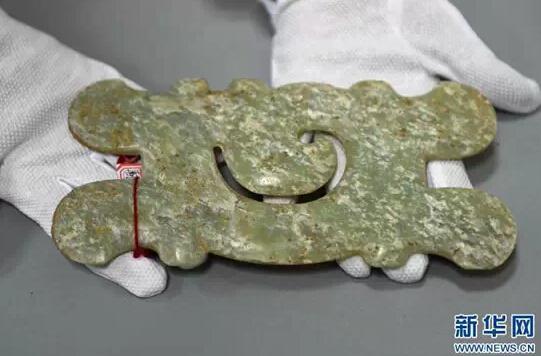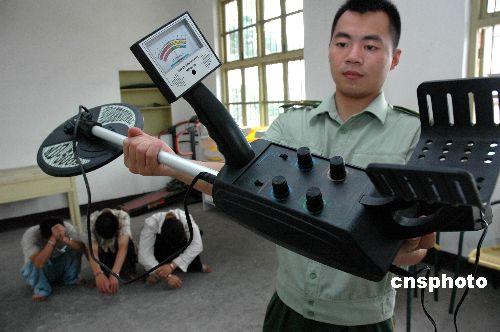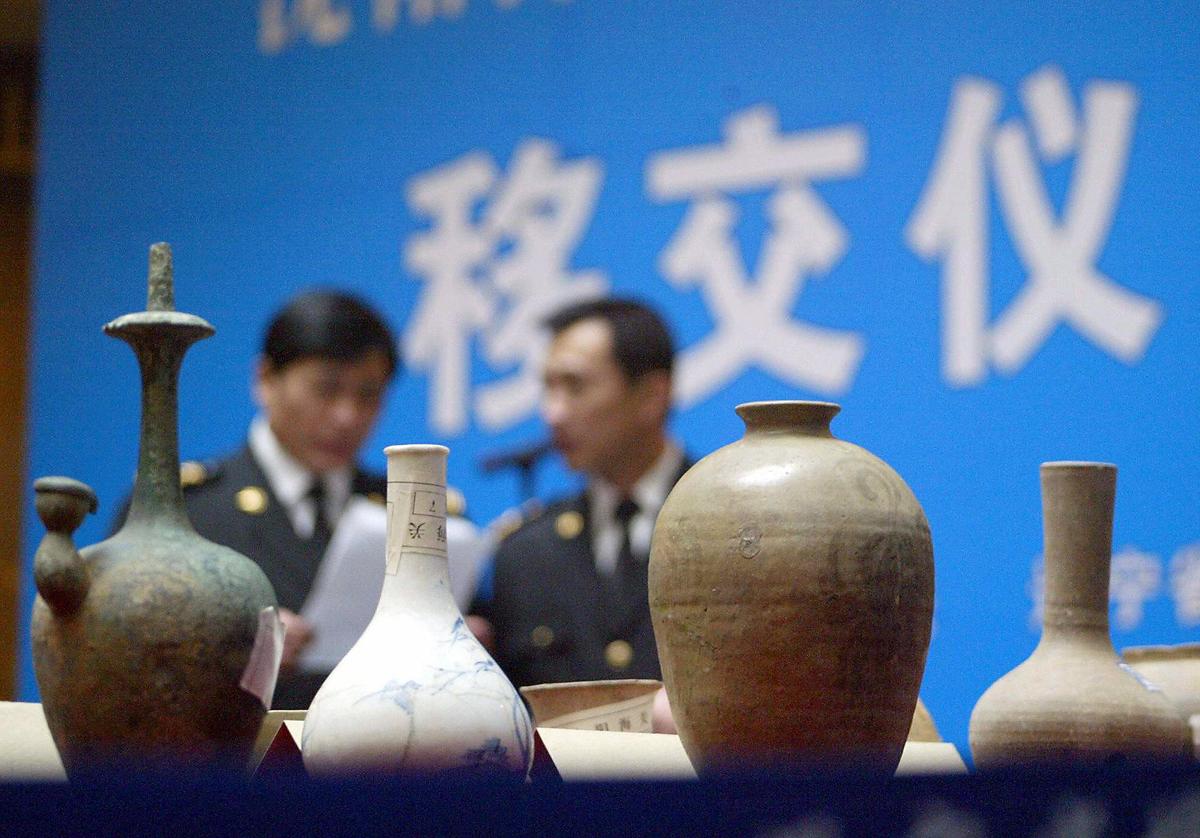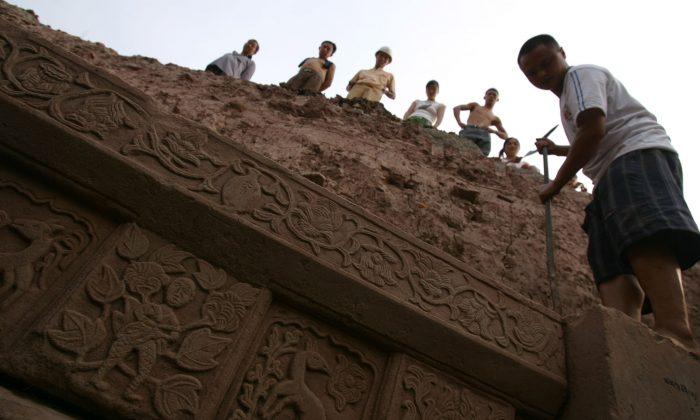“To get rich overnight, raid tombs,” goes a saying in China. It is one that many Chinese with no previous experience in archeology have taken to heart in recent years.
In May 2015, the Chinese regime’s Public Security Ministry said that it had arrested 175 people in six provinces suspected of raiding tombs, the single largest operation for decades. The network of suspected criminals was accused of stealing and trafficking over 1,000 grave relics worth about $80 million.
Four months later Li Xiaoji, the head of China’s cultural heritage protection body, told an influential Party newspaper that the task of safeguarding China’s cultural treasures was “grim” and “severe,” owing to the proliferation of organized tomb raiders equipped with high tech gear, and his own agency’s dire lack of resources.
As more Chinese find out about the riches that can be dug out of the past, they’re tapping into a wealth of tomb looting know-how, linking up with support groups on the Internet, and joining a high-tech industry built upon illicit grave robbery. But while officials in charge of cultural preservation seem to fight an uphill battle to save the country’s antiques and preserve valuable tombs, the Communist Party’s war against grave looters suffers the fatal flaw of being infiltrated by the very cadres that are eager for a slice of the lucrative tomb-raiding business.
A ‘Full-Fledged Industry’
Chinese have traditionally thought that it’s inauspicious to interfere in the affairs of the afterlife—let alone ransack the graves of ancestors. While grave robbing took place, acts of plunder in the past pale in comparison to the scale of present-day operations, according to Xie Zhensheng, the honorary president of the China Cultural Relics Society, a semiofficial cultural organization.
“Tomb raiding is already a full-fledged industry in China,” Xie told Chinese web portal Sina in December 2015.

Indeed, in 2010 there were already over 100,000 professional and amateur grave robbers alone in the provinces of Hebei, Henan, Hunan, Shanxi, Shaanxi, and Gansu, according to the state-owned provincial newspaper Chu Tian Jin Bao, citing an insider. Peasants and casual laborers make up the bulk of the amateur grave robbers, according to Fanyuan Magazine, a state-run publication.
Joining the tomb raiding movement is simple. “Xiao Hao,” an insider, told Chu Tian Jin Bao that parties eager to try their hand can sign up for classes in Henan (a rich archeological site and the home of the ancient capital of Luoyang) for about 200 yuan (about $30) a day. Land surveying skills are first taught, before progressing to probes and shovels, then finally explosives. After 10 days, adepts have the chance to assist an instructor in a real tomb robbery.
By 2012, China’s tomb raiders were running more professional operations, and even started to form syndicates and take on joint projects, according to reports on Sina and Sohu, another Chinese Web portal.
Today, a search for “tomb robbery” (”daomu”) on the Baidu, China’s largest Internet portal, reveals countless websites and online forums offering instruction on how to get into the business, how to scout virgin graves, where to find tools and equipment, and how to link up with possible partners in crime.
Depending on the location and historical period, grave robbers might come across such precious items as Neolithic pig dragon jade pieces, Shang Dynasty bronze vessels, inscribed golden plaques from the Warring States era, and stone Buddha statues from the Tang and Song dynasties.
When tomb raiders unearth artifacts or relics, their first step is often to immediately ship them abroad, Li Maizhu, the deputy director of Anyang Relic Collection Association, told First Finance, a state-owned financial news website. “If any of the antiques shipped overseas fail to fetch a better price than that on the mainland, they will be sent back to China through various channels.”

Avoiding stolen goods is possible, though, for the discerning antiquary.
Tony Dai, an antique appraiser based in New York, told the Epoch Times that most objects made of gold, silver, and bronze, as well as pottery from the earlier dynasties like the Han and Tang, are very likely taken from tombs, given burial customs of the times.
It’s even easier to tell if a jade piece has been plundered from a grave: “Jade is whitish in color, and because the gem stone will absorb dirt, those that have been buried will be soil-colored and have a noticeably different texture,” Dai said.
Fighting Tech With Tech
One of China’s oldest cities, Xi‘an in the northwest Chinese province of Shaanxi, has a history stretching back to the 11th century B.C. The ancient capital of four dynasties, Xi’an, or Chang'an before the Ming Dynasty (1368-1644), is home to some of the most well-known graves, including the Mausoleum of Qin Shihuang, the first Emperor of Qin, and his famous terracotta warriors.

The wealth of historical artifacts lying beneath the earth in Xi'an makes it a magnet for tomb raiders: between 2012 and 2014, the police caught a total of 1,246 suspects of cultural crimes in Shaanxi, and recovered 4,488 pieces of cultural relics, including 22 first-grade and 128 second-grade pieces, according to China’s State Administration of Cultural Heritage.
The official cultural protection body’s report noted that the tomb raiders were equipped with the very latest in grave robbing technology—directional blasting demolition equipment, night-vision goggles, electric saws and drills, oxygen canisters, gas masks, walkie talkies, metal detectors, and the staple Luoyang shovels—a tube-like, half-open blade attached to a long pole—that are used to probe the earth for treasure.

To deter and detect these high-tech robbers, the Shaanxi authorities spent huge amounts of money on surveillance. In September 2011, the Shaanxi Provincial Cultural Department bought 100 million yuan (about $15.6 million) worth of equipment to monitor the province’s ancient tombs, according to the state-run China Daily. A year later, the tourism bureau in Shaanxi’s Liquan County announced that it had set aside 76.6 million yuan ($12 million) for security hardware—intrusion alarm systems, audio and video security monitoring systems, electronic patrol systems, backup power systems and a police control center—to protect the Zhao Mausoleum, the burial ground of Taizong, the second emperor of the Tang Dynasty.
The public security bureau in Xi'an is boosting both manpower and introducing new anti-tomb robbery tech: in June 2015, the police held a ceremony to unveil unmanned drones that it claims will be used to prevent grave robbery, and that 10 million yuan (about $1.5 million) will be allocated to hire 5,600 “heritage defenders.”
Who Watches the Watchmen?
The Chinese regime could have been more successful in protecting the systematic plunder of its cultural relics—if only its own cadres weren’t compromised.
Mainland Chinese media frequently report cases of official-robber collaborations. In 2003, 13 tomb robbers in the Xia County in Shanxi Province were found to have conducted their illegal activities undetected for a long stretch of time because they were being “protected” by three policemen from the local public security bureau, according to Xinhua, the state mouthpiece. The following year, Bao Weidong, a deputy head of the security bureau at Ejin Banner, Inner Mongolia, was caught red handed robbing an ancient temple.

Some state archaeologists have also been exposed for leading double lives: humble protector and preserver of China’s ancient material culture by day, unscrupulous tomb raider by night, according to a September 2010 report by Chinese Social Sciences Today. Further, local governments have been known to hire actual grave robbers to work on archaeological sites, a situation caused by the shortage of professional archaeologists in the country.
Top government officials and even lawmen are implicit in the grave robbing “chain of interest,” according to Fanyuan Magazine.
“Antique dealers would collude with grave robbers and send their unearthed treasures to high-ranking officials who are antique collectors themselves. And then business executives buy the treasures off the officials. Some law enforcement officials would even replace antiques that are worth tens of millions with a fake ones during their criminal investigations of grave robbery cases,” the piece continued.
Tony Dai the New York antique appraiser told the Epoch Times one anecdote of this sort of unhealthy intermingling of interests.
Dai’s friend in China, also an antiquer, once encountered a group of men involved in grave robbery, and through them was introduced to the police in charge of anti-tomb raiding operations. As it turned out, the police were the thieves’ closest business partners.
“The grave robbers were handing all their stolen goods directly to the police to sell on their behalf and avoid an inspection,” Dai said. “So the grave robbers were in fact in business with the police.”






Friends Read Free